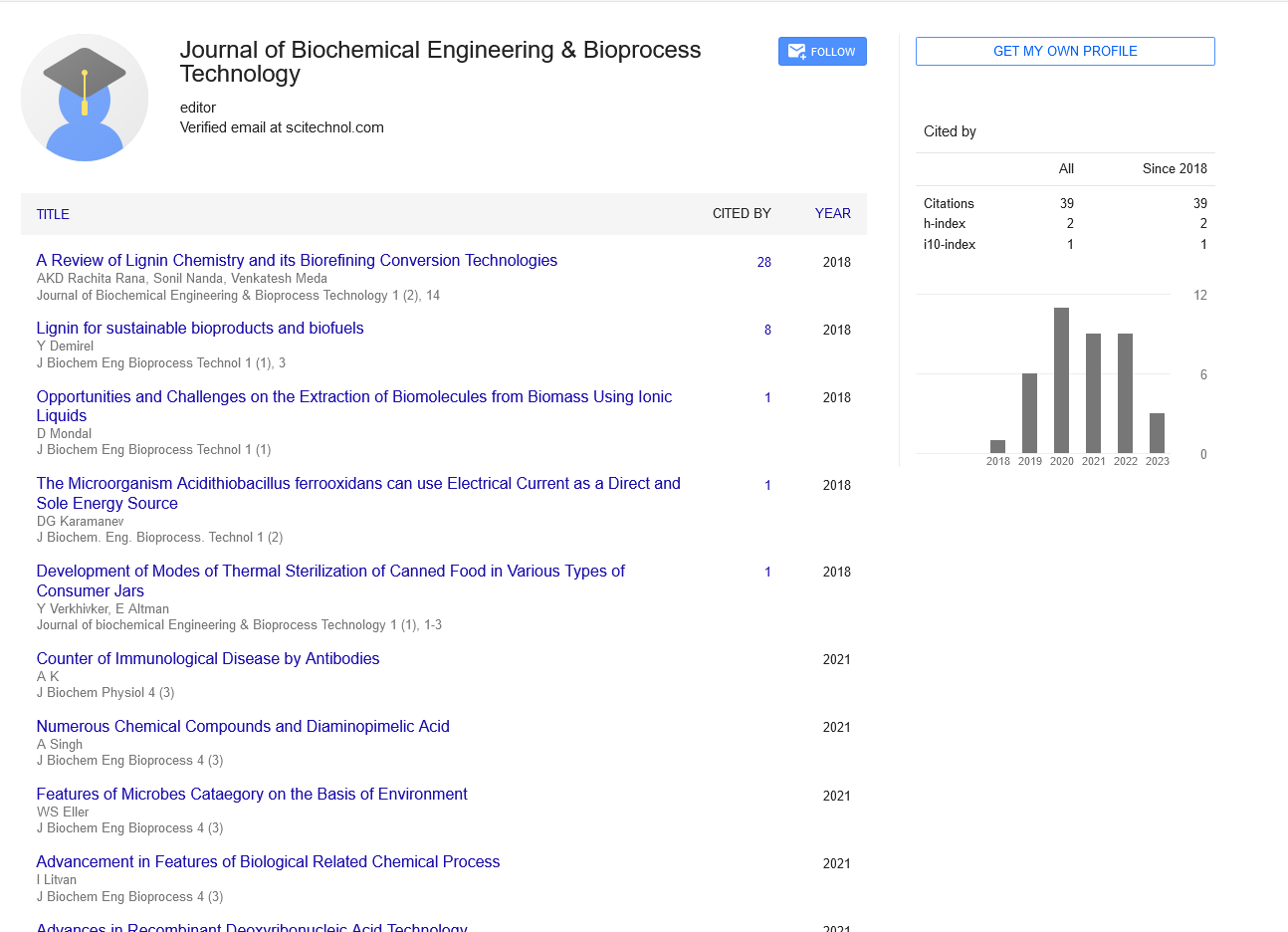Perspective, J Biochem Eng Bioprocess Vol: 6 Issue: 2
Bioprocess Monitoring and Control: Cutting-edge Techniques for Quality and Yield Improvement
Yasmitha Goud*
1Department of Biochemical Engineering & Bioprocess Technology, Indian Institute of Technology Delhi, New Delhi, India
*Corresponding Author:Yasmitha Goud,
Department of Biochemical Engineering
& Bioprocess Technology, Indian Institute of Technology Delhi, New Delhi, India
E-mail: goudy156@gmail.com
Received date: 22 May, 2023, Manuscript No. JBEBT-23-106933;
Editor assigned date: 24 May, 2023, Pre QC. JBEBT-23-106933 (PQ);
Reviewed date: 15 June, 2023, QC No. JBEBT-23-106933;
Revised date: 22 June, 2023, Manuscript No. JBEBT-23-106933 (R);
Published date: 29 June, 2023, DOI: 10.35248/jbebt.1000061.
Citation: Goud Y (2023) Bioprocess Monitoring and Control: Cutting-edge Techniques for Quality and Yield Improvement . J Biochem Eng Bioprocess 7:2
Keywords: Bioprocess
Description
Bioprocess monitoring and control play an essential role in ensuring the quality and yield improvement of biochemical production. This study provides a brief overview of the cutting-edge techniques employed in bioprocess monitoring and control for the optimization of bioprocesses. It explores key monitoring techniques such as online sensors, spectroscopy, and omics technologies for real-time data acquisition. Additionally, it discusses advanced control strategies, including model-based control, feedback control, and optimization algorithms, to maintain optimal process conditions. Furthermore, the study highlights the integration of cutting-edge techniques for improved process understanding, enhanced productivity, and highquality biochemical production.
Online sensors: Real-time process monitoring
Online sensors enable real-time monitoring of key process parameters during bioprocesses. This section explores the use of online sensors, such as dissolved oxygen sensors, pH sensors, and biomass sensors, for the continuous measurement of acute variables. It discusses how online sensors provide real-time data, allowing for rapid feedback control and the detection of process deviations. Additionally, it highlights the integration of advanced sensors, such as Near-Infrared (NIR) and Raman spectroscopy, for the non-invasive analysis of cell culture and bioreactor conditions.
Spectroscopy: Probing bioprocesses at a molecular level
Spectroscopic techniques offer valuable insights into bioprocesses by probing molecular changes and composition. This section discusses the use of spectroscopy, such as Infrared (IR) spectroscopy and fluorescence spectroscopy, for monitoring and characterizing bioprocesses. It explores how spectroscopy techniques can provide information about nutrient utilization, metabolite concentrations, and cell physiology. Additionally, it highlights the potential of spectroscopic techniques for real-time, non-destructive analysis of bioreactor conditions and monitoring of biochemical parameters.
Omics technologies: Comprehensive process characterization
Omics technologies, including genomics, transcriptomics, proteomics, and metabolomics, offer a comprehensive understanding of bioprocesses by analyzing molecular components and their interactions. This section explores the use of omics technologies for characterizing bioprocesses and elucidating metabolic pathways and regulatory networks. It discusses how genomics and transcriptomics provide insights into genetic modifications and gene expression levels. Furthermore, it highlights how proteomics and metabolomics enable the identification and quantification of proteins and metabolites, facilitating the understanding of cellular responses and metabolic fluxes.
Advanced control strategies: Optimizing process conditions
Advanced control strategies play a vital role in maintaining optimal process conditions and maximizing biochemical production. This section discusses model-based control, feedback control, and optimization algorithms as cutting-edge control strategies. It explores how model-based control employs mathematical models to predict and control process behavior. It discusses the importance of feedback control in adjusting process parameters based on real-time data and maintaining process stability. Additionally, it highlights the potential of optimization algorithms, such as genetic algorithms and dynamic optimization, in maximizing process performance and optimizing bioprocess conditions.
Integration of cutting-edge techniques: Improved process understanding
The integration of cutting-edge monitoring and control techniques offers improved process understanding and enhanced productivity. This section discusses how the integration of online sensors, spectroscopy, and omics technologies allows for a more comprehensive and real-time assessment of bioprocesses. It emphasizes the importance of data integration and analysis techniques, such as multivariate analysis and data-driven models, for extracting valuable insights and correlations. Furthermore, it highlights how the integration of advanced control strategies with real-time monitoring techniques enables dynamic process optimization and adaptive control.
Conclusion
Cutting-edge techniques in bioprocess monitoring and control offer significant advancements for quality and yield improvement in biochemical production. Online sensors, spectroscopy, and omics technologies provide real-time data acquisition and comprehensive process characterization. Advanced control strategies enable optimal process conditions and maximize productivity. The integration of these techniques enhances process understanding and facilitates dynamic process optimization. Continued research and development in bioprocess monitoring and control will further contribute to the efficient and high-quality production of biochemicals, driving advancements in bioprocess technology.
